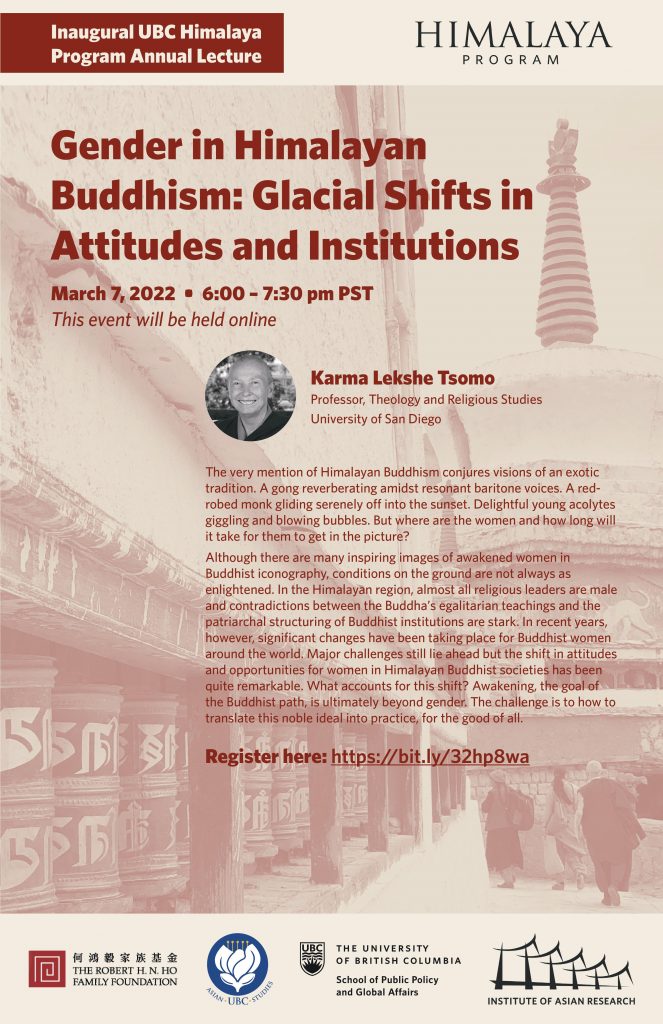Gender in Himalayan Buddhism: Glacial Shifts in Attitudes and Institutions
December 19, 2021
Join us in the Inaugural UBC Himalaya Program Annual Lecture!

The very mention of Himalayan Buddhism conjures visions of an exotic tradition. A gong reverberating amidst resonant baritone voices. A red-robed monk gliding serenely off into the sunset. Delightful young acolytes giggling and blowing bubbles. But where are the women and how long will it take for them to get in the picture?
Although there are many inspiring images of awakened women in Buddhist iconography, conditions on the ground are not always as enlightened. In the Himalayan region, almost all religious leaders are male and contradictions between the Buddha’s egalitarian teachings and the patriarchal structuring of Buddhist institutions are stark. In recent years, however, significant changes have been taking place for Buddhist women around the world. Major challenges still lie ahead but the shift in attitudes and opportunities for women in Himalayan Buddhist societies has been quite remarkable. What accounts for this shift? Awakening, the goal of the Buddhist path, is ultimately beyond gender. The challenge is to how to translate this noble ideal into practice, for the good of all.
 Karma Lekshe Tsomo, a specialist in Buddhist studies, has taught at University of San Diego since 2000. She offers classes in Buddhist Thought and Culture, World Religions, Comparative Religious Ethics, Religious and Political Identities in the Global Community, and Negotiating Religious Diversity in India. Her research interests include women in Buddhism, death and dying, Buddhist feminist ethics, Buddhism and bioethics, religion and politics, Buddhist social ethics, and Buddhist transnationalism. She integrates scholarship and social activism through the Sakyadhita International Association of Buddhist Women and Jamyang Foundation, an innovative education project for women in developing countries, with 15 schools in the Indian Himalayas, Bangladesh, and Laos.
Karma Lekshe Tsomo, a specialist in Buddhist studies, has taught at University of San Diego since 2000. She offers classes in Buddhist Thought and Culture, World Religions, Comparative Religious Ethics, Religious and Political Identities in the Global Community, and Negotiating Religious Diversity in India. Her research interests include women in Buddhism, death and dying, Buddhist feminist ethics, Buddhism and bioethics, religion and politics, Buddhist social ethics, and Buddhist transnationalism. She integrates scholarship and social activism through the Sakyadhita International Association of Buddhist Women and Jamyang Foundation, an innovative education project for women in developing countries, with 15 schools in the Indian Himalayas, Bangladesh, and Laos.
Read More | No Comments
 Karma Lekshe Tsomo, a specialist in Buddhist studies, has taught at University of San Diego since 2000. She offers classes in Buddhist Thought and Culture, World Religions, Comparative Religious Ethics, Religious and Political Identities in the Global Community, and Negotiating Religious Diversity in India. Her research interests include women in Buddhism, death and dying, Buddhist feminist ethics, Buddhism and bioethics, religion and politics, Buddhist social ethics, and Buddhist transnationalism. She integrates scholarship and social activism through the Sakyadhita International Association of Buddhist Women and Jamyang Foundation, an innovative education project for women in developing countries, with 15 schools in the Indian Himalayas, Bangladesh, and Laos.
Karma Lekshe Tsomo, a specialist in Buddhist studies, has taught at University of San Diego since 2000. She offers classes in Buddhist Thought and Culture, World Religions, Comparative Religious Ethics, Religious and Political Identities in the Global Community, and Negotiating Religious Diversity in India. Her research interests include women in Buddhism, death and dying, Buddhist feminist ethics, Buddhism and bioethics, religion and politics, Buddhist social ethics, and Buddhist transnationalism. She integrates scholarship and social activism through the Sakyadhita International Association of Buddhist Women and Jamyang Foundation, an innovative education project for women in developing countries, with 15 schools in the Indian Himalayas, Bangladesh, and Laos.